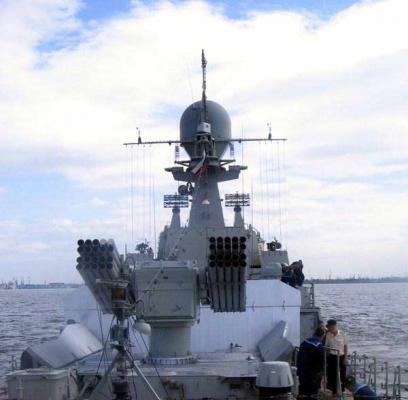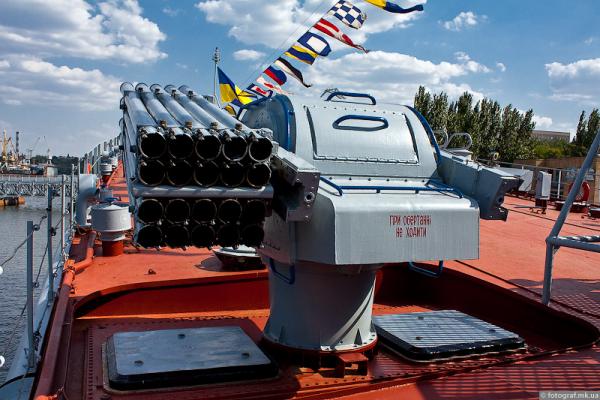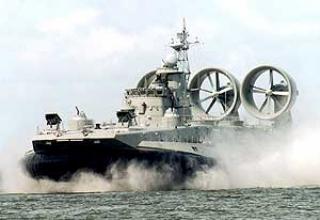122 mm A-215 "Grad-M" multiple rocket launcher system is designed to destroy manpower and equipment on the shore during the landing of the sea, to support its actions, as well as to protect landing ships from attacks by enemy ships at the crossing of the sea. High speed and range of fire provide effective fire support for the sea landing party.
Tactical and technical task for the development of the ship 122-mm RSZO A-215 on the basis of land RSZO 9K51 "Grad" was approved by the Deputy Chief Naval Officer January 12, 1966. The first prototype of the launcher was manufactured in the middle of 1969 at Plant 172. In the 3rd-4th quarters of 1969 it passed factory tests in Perm, and then was sent for ground testing. In the 1st quarter of 1970 the plant delivered the second copy. The charger and other sub-floor parts of the plant were produced at the Barrikady plant.
Ship tests of A-215 complex were carried out on the Baltic Sea from March 20 to May 7, 1972 on a large landing ship BDK-104 of project 1171 (factory number 300). During the tests 300 shots were fired by the army shell M-21OF at sea disturbance up to 6 points. There were no failures or delays, except for unreliable operation of the contacts of the shells in the launcher guides.
Based on the results of the ship tests, A-215 was recommended for service with Project 1171 (factory No. 295-301 ff.) and Project 1174 (one launcher, 320 missiles). Later CRIAG MOP and LOMO (Leningrad Optical and Mechanical Association) developed a scheme of autonomous indirect stabilization. On its basis in 1977 was created a new rangefinder device TLD-2. The A-215 system with TLD-2 was adopted for service in 1978.
The upgraded A-215 "Grad-M" RSF is a part of the weaponry of small artillery ships of the 21630 "Buyan" series. The head ship of the 21630 project was laid down on January 30, 2004 in St. Petersburg at the shipyard of OAO "Almaz" and was named "Astrakhan" (h/n 701). On October 7, 2005 the ship was launched and in 2006 it went into service. By 2010 it is planned to build 7 ships of this series at "Almaz" shipyard (according to other data - 10 ships by 2015).
The advertising passport for the small rocket (artillery) ship of project 21632 "Tornado" (approved on 26.04.2008.) indicates the possibility of placing one MS-73 installation for 40 shells on the artillery version of the ship (see the scheme). The purpose of the ship version is to conduct combat operations in the seas and on navigable rivers, solving peacetime tasks in the area of responsibility of the association.
Two A-215 systems with a total ammunition capacity of 320 missiles are placed on the new big landing ship (BDK) of project 11711 (developed in Nevsky PKB). The lead ship of the series, named "Vice-Admiral Ivan Grene", was laid down at the Baltic Shipyard "Yantar" in Kaliningrad in December 2004, and the launch date of the fleet is early 2009.
Composition:
The A-215 "Grad-M" complex is a part of it:
- Deck launcher MS-73 (MS-73M) with sub deck charger (see photo), (see diagram),
- laser rangefinder sighting device TLD-2,
- the PS-73 Thunderstorm firing control system,
- 122mm unguided rockets (NURS).
The main type of ammunition is the 9M22U fragmentation projectile, which provides the system with a range of up to 20 km. It is equipped with 160 rounds of ammunition.
For remote guidance and stabilization in sea rocking conditions, the MS-73 is equipped with tracking drives. Deck-type drum-type charger accommodates 8 launch packs of 20 NURS each. When charging, the pouches are fed in pairs to the PU rails exposed vertically. After the volley, the empty pouches are lowered into the drum and the next pair is fed to the rails. The charging time of the starter unit is not longer than 50 seconds and the recharging time is 2 minutes.
Firing is automatic according to the data of the firing control system, either in volley or single-handed mode. The interval between shell launches in salvo is 0.5s. The launcher allows a deep upgrade in terms of types and calibers of ammunition, up to the use of short-range air defense missiles. It is possible to integrate the AP into a single launch vehicle missile-artillery complex. There is an option of placing the launcher without a charger with a single salvo, recharging manually.
A system of firing control devices (FLS) PS-73 "Thunderstorm" was developed for the complex. The Thunderstorm control system provides indication of shells presence in the guides; automatic reception of current target coordinate values; automated and continuous development of full angles of the launcher; issuing a command to launch the shells.
The improved A-215M complex was built on the basis of the MS-73 launcher and the modern SP-520M-2 optical-electronic control system. The complex, along with the standard rockets 9M22U introduced long-range rockets 9M521, providing shrapnel and blast damage to targets at ranges up to 40 km. The firing control system is coupled with the ship's state-of-the-art radar facilities and ensures high speed and accuracy of data production for firing, including at unobserved targets. In order to improve the effectiveness of shrapnel hitting targets, it is planned to use the 9M522 missile with a detachable shrapnel-head. By ensuring a vertical approach to the target of the warhead, its fragmentation effectiveness increases by a factor of 6 in relation to 9M22U.
Characteristics:
| Caliber, mm | 122 |
| Shaft number | 40 |
| The range of fire is maximum, m | 20700 |
| Range of fire minimum tabular, m | around 2,000 |
| Angle of vertical guidance, hail | between -6 and +93 |
| Angle of horizontal guidance, hail | ±164 |
| Vertical Guidance Speed, deg/s | 26,4 |
| Horizontal pointing speed, deg/s | 29 |
| Weight of unit with storage and feeding devices, kg | 16500 |
| Weight of the complex without shells and ZIP, kg | 20727 |
| Weight of the complex with shells and ZIP, kg | some 31,000 |
| The size of the cellar, m: - length - width - altitude |
4.5 4 3.8 |
| Dimensions of PU in camping position without bags, mm: - width - altitude |
1710 2100 |
| Swimming radius, mm | 1500 |
| Calculation, man. | 2 |
| The interval between the launches of shells in the salvo, s | 0,5 |
| Charging time from the first shot, s | 46 |
| Recharging time, s | 120 |
| Time of firing of all ammunition, mines. | 7,3 |
Testing:
On 28 June 2000 (or 2008, which is more likely), 25 Grad-M multiple launch rocket systems were delivered to Georgia via the delivery channel from the settlement of Oktyabrsky to the settlement of Batumi by the ship "Evgenia N". The firm-supplier is SC "Ukrspetseksport".
Sources:
- Ксерокопия рекламного паспорта №2609/08/НЭК малый ракетный (артиллерийский) корабль проекта 21632 "Торнадо". Утвержден 26 апреля 2008 года. - С.(20)19.
- Шунков В.Н. "Ракетное оружие" .-Мн.: ООО "Попурри", 2001- 528с.
- Малые артиллерийские корабли типа "Астрахань" Проект 21630 "Буян"
- http://fotosila.livejournal.com/1238.html?thread=7638
- http://03013.ucoz.ru/forum/3-21-1



